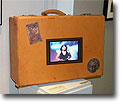David Rockefeller Center for Latin American studies,
Oct 01, 2004 - Jan 05, 2005
Cambridge, MA, USA
Adal Maldonado
by Madeline Medeiros Ruiz
Overall, the Harvard portion of the ADÁL show provides a rather clear, visual synopsis of the artist’s career, allowing the viewer to trace backwards from his latest work to his earliest. A few subway stops away, the exhibition held at Casa de la Cultura/Center for Latino Arts is represented in a 2-room, one floor gallery space. Anti-climactically, there are several works re-exhibited here, including the photographs of Los Out of Focus Nuyoricans, an aged map of ADÁL’s invented land, El Spirit Republic de Puerto Rico, examples of passports, and one of ADÁL’s responses to the 9/11 attacks on the United States, El Santo Barroso Anti-Terrorist Spray print (Santo Barroso is the patron saint of El Spirit Republic) from 2001.
Less powerful works were exhibited at this location, in part because of their inherent one-liner delivery which had a kind of ad nauseum effect on this reviewer. Works such as the $100 dollar bill with a cock replacing the face of Benjamin Franklin entitled El Currency have an immediate shock value, but limited lasting poignancy. Brazilian artist Cildo Meireles produced a work like this back in the 1970s, replacing the dollar amount with zeros and actually reinserting the bill back into public circulation as a means of subverting a global system run in large part on US currency. ADÁL does this with his bill, but the level of intended consequence is limited to the gallery setting, and the ultimate effect is one of rebellion rather than subversion. He has created a currency for El Spirit Republic de Puerto Rico that refers to the currency of the United States, acknowledging an inability to establish a clear break from the superpower’s influence, even in the case of a theoretical territory.
Additionally, ADÁL’s El Rice and Beans Spanglish Sandwich (2003), a photograph of a sandwich made up of red beans and rice, digitized onto a plate and set next to a brown paper lunch bag is reminiscent of Ana Bella Geiger’s 1978 O Pao Nosso (Our Daily Bread), which incorporated photographs of a piece of bread with the shape of Brazil’s land cut out of the center, with a waxy, brown bread bag. Both the ADÁL and Geiger piece confront a cultural food icon of sorts, red rice and beans by the former, and the bread and bread bag by the latter. ADÁL’s version touches on the cultural adaptation that unavoidably occurs for any Nuyorican. The correlation between both of these ADÁL works and the Brazilian works is not surprising; subversion and parody of the culturally identifiable was used by many Brazilian artists under dictatorial rule in the 1970s as they felt the need to acknowledge and respond to their government and their every-evolving identity as a people.
Other works carry this same theme, such as the captivating video piece El West Side Story Upside Down Sideways Backwards and Out of Focus (2004) and a grid-like arrangement of 42 digitally enhanced photographs entitled Los Coconauts in Space (2004), meant to encourage the viewer to reconsider history by contemplating where we get our information. The Coconaut series, exhibited earlier this year at Taller Puertoriqueno, Inc. in Philadelphia, are arranged photographs that are mean to satirically suggest that perhaps the United States was not the first to step foot in an extraterrestrial sphere. Here black and white photographs are presented as evidence that the people of El Spirit Republic de Puerto Rico had endeavored into space six years prior to the US and landed on (the fictitious) Star Luna. It is not the validity or falsity of this presentation that ADÁL is interested in, but rather the possibility that there may be other sides to every story.
In that same line of thought, ADÁL’s goal is to set up a dialogue for the very issues he presents in his art and in his writing. Throughout both sites, various text panels are displayed: transcribed interviews, curatorial texts, El Puerto Rican Embassy’s Manifesto from 1994, among others. The artist’s message regarding the disenfranchised status of Puerto Ricans in the US is abundantly clear, verging on overstatement. There is a level of rebelliousness demonstrated by having a show like this held within the Latin American Center framework - these are institutions meant to encourage awareness, understanding, and unity - which, in a sense, the exhibition tries to do by highlighting the discrepancies, the out-of-focusness of the Puerto Rican identity in the US, and simultaneously embracing this irregularity. But is the message less effective by holding exhibitions like this within institutions such as these? Is the point to address these issues to a specific Latino and Latin American audience, or to a wider, more culturally diverse one? While the show, at times, presents itself as a kind of one-man diatribe against the entire US system rather than a launching pad for inter-cultural dialogue, the veritable marginalization of this two-part show to Latino and Latin American audiences does prove itself as an overwhelming dilemma - especially when the goal is dialogue, which by definition necessitates more than one person, and in this case, more than one kind of person.
|









